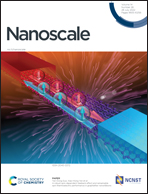Mosquito-inspired design of resistive antennae for ultrasensitive acoustic detection†
Abstract
Mosquito antennae are unique one-dimensional (1D) soft auditory systems, enabling highly sensitive and specific detection of the surrounding acoustic signals for routine movement and communications. Here we report on a mosquito-inspired design of a free-standing 1D acoustic sensor, comprising repeating soft joints (cracked Pt film) and rigid segments (non-cracked Pt film). The soft cracked Pt joints serve as highly sensitive resistive sensors to vibrational strains while the rigid segments are insensitive to acoustic pressures. By adjusting the joint positions and densities, we can fine-tune the sensor's acoustic sensing performance. We further designed unevenly spaced soft joints to mimic male and female mosquito antennae, and found that the artificial female antennae can achieve a wide sensing range (∼80 to ∼2000 Hz), ultrahigh sensitivity (19.17 Pa−1), low detection limit (58.4 dB), and fast response (1.14 ms). Finally, we demonstrate the proof-of-concept of an artificial mosquito that can respond to specific frequencies related to real-world events in real time.



 Please wait while we load your content...
Please wait while we load your content...